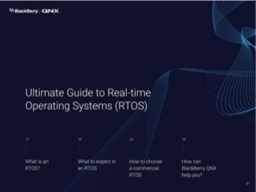Ultimate Guide to Real-time Operating Systems (RTOS)
A real-time operating system (RTOS) must be fast and responsive, schedule tasks and manage limited resources, and ensure functions are isolated and free of interference from other functions.
In this report, you'll learn more about what is a real-time OS and the pros and cons of two types of RTOS architectures: monolithic and microkernel.
Read More
By submitting this form you agree to BlackBerry QNX contacting you with marketing-related emails or by telephone. You may unsubscribe at any time. BlackBerry QNX web sites and communications are subject to their Privacy Notice.
By requesting this resource you agree to our terms of use. All data is protected by our Privacy Notice. If you have any further questions please email dataprotection@techpublishhub.com
Related Categories: Cellular, Communication, Development and debug tools, Edge computing, Embedded, Embedded operating systems and software, Evaluation boards, LPWAN technologies, Microcontrollers, Near-Field Communication (NFC), SBCs and modules, Sub-GHz/ISM-band radio, Wireless networking ICs and modules


More resources from BlackBerry QNX

Ultimate Guide to Real-time Operating Systems (RTOS)
A real-time operating system (RTOS) must be fast and responsive, schedule tasks and manage limited resources, and ensure functions are isolated and...

5 Reasons to Consider an Alternative to Linux for Your Medical Device
Medical device designers have become increasingly interested in the Linux® operating system (OS), largely because of its open source model. Linux ...

Ten Principles for Building Safe Embedded Software Systems
Obtaining safety certifications and pre-market approvals for safety-related systems is arduous, costly, and prone to failure. And yet such certific...
